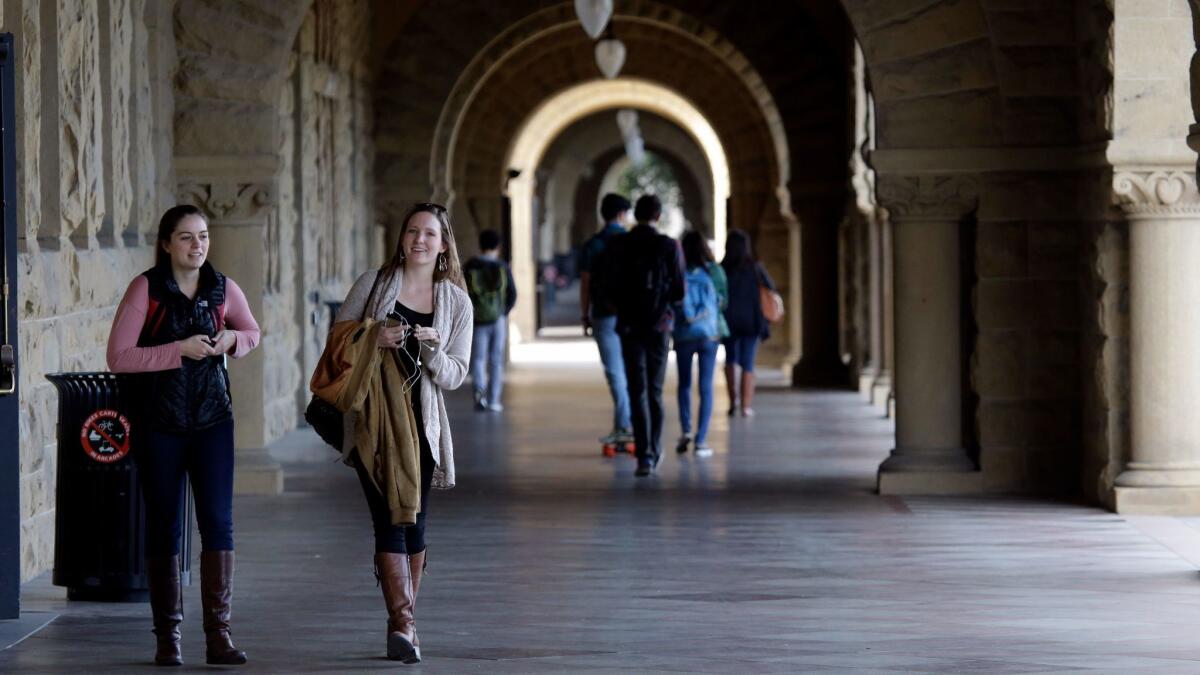Op-Ed: Stanford can take Junipero Serra’s name off its buildings, but it can’t purge him from its history

Stanford University is in a bind between political correctness and historical fact. Two dorms; an academic building; a street (Serra Mall) that fronts Stanford’s historic Main Quad and is the university’s official address; and a major road running through the 8,000-acre campus are all named after Junipero Serra, the 18th century Spanish-born Franciscan friar who founded the first nine of the 21 California missions. Now Native American and other campus activists are pressuring Stanford to erase from the campus all traces of the padre. Serra, the activists say, brutalized Indians at the missions, covered for Spanish colonization and squelched indigenous culture by converting the Indians to Catholicism.
Stanford administrators have been wringing their hands over all this since March 2016, when the student assembly passed a resolution calling for the renaming of three buildings and a change of the university’s official address. (Stanford doesn’t have the power to rename the Mall, its campus extension, Serra Street, or the bigger public thoroughfare Junipero Serra Boulevard.) The Stanford Graduate Council and the Faculty Senate quickly joined in. The university set up a committee to recommend new names, but after a year and a half of inability to come to a consensus, the committee announced in October that it was giving up and would instead issue guidelines for future deliberations.
That decision didn’t sit well with some students and alumni. One Native American activist called it a “slap in the face.” And indeed Stanford does seem to be missing out on a growing trend of altering campus infrastructure whose original namesakes are no longer in compliance with current notions of political acceptability.
If the Stanford activists aim to obliterate Serra’s presence from their campus, they’ve got their work cut out for them.
Earlier this year, Yale changed the name of its Calhoun College because John C. Calhoun, in addition to being a Yale alumnus and a former U.S. vice president, was a leading pre-Civil War advocate of slavery. Duke University took down a statue of Robert E. Lee. Just a few days ago, the regents of the University of New Mexico agreed to a redesign of the university seal, which includes images of a frontiersman and a conquistador that Indian activists consider offensive. Meanwhile, at Princeton, the trustees decided not to bend to student protesters demanding the removal of the name of famous alumni (and segregationist) Woodrow Wilson from dozens of campus buildings and institutions. Instead, the university sponsored an exhibition on campus exploring the former president’s flawed nature.
Serra’s nature is open to debate. Once revered in history books as a protector of California Indians against the brutalities of the invading Spanish military — and canonized as a saint by Pope Francis in 2015 — Serra’s reputation has been tarnished by leftist thinking that regards all things Spanish and Catholic in the New World as colonialist oppression.
But that ought to be beside the point. Serra is inextricably intertwined with the history of Stanford University, and the history of California itself. He cannot be easily purged.
Indeed, Serra could be said to have invented the Golden State. The missions that he and his successors founded were the vertebrae that formed the spine of El Camino Real (pretty much coterminous with U.S. 101), the path that connected the missions, most of them separated by just a day’s horseback ride. Every major city in California — San Diego, Los Angeles (thanks to its proximity to San Gabriel), San Jose, San Francisco — lies on the mission trail.
Serra was, if nothing else, a gifted administrator, introducing cattle and wine grapes as staples of California agriculture. (His successor, Father Fermín Lasuén, brought in the first olive trees.) He engaged in constant, well-documented and often fractious turf battles with secular Spanish authorities. And as a matter of aesthetics and lifestyle, California Mission architecture, in a massive revival starting in the 1880s, became the state’s signature building mode, dotting the landscape with thousands of tile-roofed, colonnaded and court-yarded churches, civic buildings, hotels, shopping malls and residences.
Among those caught up in the Mission Revival craze were railroad tycoon Leland Stanford and his wife, Jane, the university’s founders, in 1885. The pair weren’t Catholics or even especially religious, but they considered Serra a towering California figure.
El Camino Real runs just outside the front portals of the campus, the couple’s former horse farm in Palo Alto. The Main Quad, part of a master plan designed by landscape architect Frederick Law Olmstead, imitates Serra’s missions (with some Romanesque touches). Besides the Mall and the boulevard, other campus streets are named after his friar-disciples (Lasuén and Francisco Palóu), as well as José de Gálvez, the inspector general for New Spain who facilitated Serra’s missionary work in Alta California. If the Stanford activists aim to obliterate Serra’s presence from their campus, they’ve got their work cut out for them.
The ancient Romans invented the practice of damnatio memoriae (“condemnation of memory”), in which all traces of those who had fallen from political favor were systematically removed after their deaths from public squares, coins and documents. Today’s version turns human beings of complex mores and motivations into cardboard villains for leftists to stomp on. But it tells a lie in the name of reinvention. Stanford is free, of course, to rename parts of itself and to pretend that a man revered by its founders never existed. But it can’t make the very foundations of California history go away — and that’s what winning the war against Junipero Serra would require.
Charlotte Allen graduated from Stanford in 1965.
More to Read
A cure for the common opinion
Get thought-provoking perspectives with our weekly newsletter.
You may occasionally receive promotional content from the Los Angeles Times.










